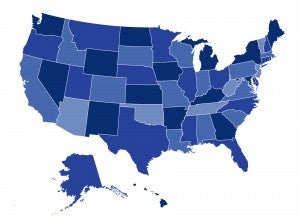
By Emily Curran, Justin Giovannelli, Kevin Lucia and Sabrina Corlette
Health insurers suffered early financial losses on their Affordable Care Act (ACA) marketplace business last year, leading many to scale back participation and increase premiums for 2017. Though analysts saw evidence of stability after these adjustments, recent federal efforts to repeal and replace the ACA have sparked growing concerns about the marketplace’s sustainability. No doubt, the individual market continues to present business challenges for many insurers, and insurer participation on the marketplaces has varied substantially, both across and within states. And yet, as one insurer put it, much of the conversation about the marketplaces has come to be dominated by “unfounded headlines” (Centene) about market instability. In reality, several large insurers that have maintained a big stake in the marketplaces expect business to improve or stabilize in 2017—provided the Trump administration ceases its efforts to undermine the market.
To understand how insurers are faring in the marketplaces amidst federal reform activity, we reviewed the first quarter (Q1) financial earnings of seven of the largest, publicly traded insurers: Aetna, Anthem, Centene, Cigna, Humana, Molina, and UnitedHealthcare. As of Q1, Anthem, Centene, and Molina each serve over one million marketplace members, Cigna and United serve an estimated 350,000-550,000,[1] and Aetna and Humana serve less than 200,000. Though these reports provide a limited scope, they help shed light on emerging trends in the market, as well as reactions to recent policy proposals.
Insurers Get a Handle on the 2017 Marketplace: “So Far, So Good”
While Aetna and Humana announced early on their intent to leave the 2018 market, they, along with others, report that their 2017 losses will be “significantly less” (Aetna) than in 2016. In fact, those with the largest shares of marketplace enrollment are beginning to see signs of improved financial conditions. For example, Anthem noted that some markets are “operating on a sustainable basis,” and continues to project that its individual business will “break even, maybe a little bit better,” while Centene characterized the marketplace as “a very good business.” Even United, which exited most marketplaces in 2016, still sees potential in the marketplace, especially if the Trump administration grants greater flexibility to insurers to comply with the ACA’s insurance standards..
Other insurers are starting to realize the benefits of early investments, including Cigna, which reported that it has seen “some successful recipes” with its “collaborative models” (also known as “accountable care organizations” or ACOs), and Molina, which retained 80 percent of its 2016 membership and has made efforts to improve its risk assessment and engagement with members.
The majority of insurers were pleased with the final market stabilization rule issued in April, modifications to the risk adjustment formula and better eligibility verifications for special enrollment periods, which they believe will have a “long term positive impact” (Anthem). Insurers continue to advocate for other revisions, including the repeal of the health insurer tax (United), additional funding for those between 100 and 300 percent of the federal poverty level (Centene), and funding for high-risk and reinsurance pools (Anthem).
Uncertainty Around Federal Action Threatens 2018 Participation
Despite signs of progress, several insurers have declared that their 2018 participation will be largely influenced by federal action, as they struggle to predict what legislative and regulatory changes are coming. Among their most pressing concerns are funding for cost-sharing reductions (CSRs) and the enforcement of the individual mandate, two pillars of the health law that, if further undermined, would jeopardize continued participation.
On their calls, Molina stated that CSR funding is “almost certainly a requirement” for continued participation in 2018, while Centene explained that rolling back these subsidies “would eliminate the affordability” of their products. Likewise, Anthem warned that if funding is not a certainty by early June, it may need to adjust filed rates, which could include “reducing service area participation” or exiting markets altogether. Even the insurers that have mostly withdrawn for 2018 say that potential legislative changes still create “uncertainty for our business” (Humana), and having “no insight” on reforms like the repeal of the health insurer tax “has an impact on affordability and the uptake of the participation” in certain markets (United).
Looking Forward
While the marketplace has presented challenges for insurers, those that remained in 2017 are cautiously optimistic that their business is beginning to improve and will be sustainable. While they anticipate some financial losses, most planning to participate in 2018 consider the most pressing threat to their continued participation to be mixed messaging and uncertainty caused by federal policymakers.
Insurers have made it abundantly clear that funding for CSRs and the enforcement of the individual mandate are critical components to keeping the marketplaces afloat. If Congress and the Administration want to ensure competition and consumer choice in 2018, they should heed insurers’ warnings and provide clarity and support. If not, insurers will be motivated to exit and substantially increase premiums.
[1] As of Q1, Cigna’s total individual commercial membership was 353,000, while United’s was 585,000. The companies’ ACA-compliant memberships are likely to be lower than the total individual commercial memberships.
Editor’s Note: This post was made possible by a generous contribution from The Commonwealth Fund.

